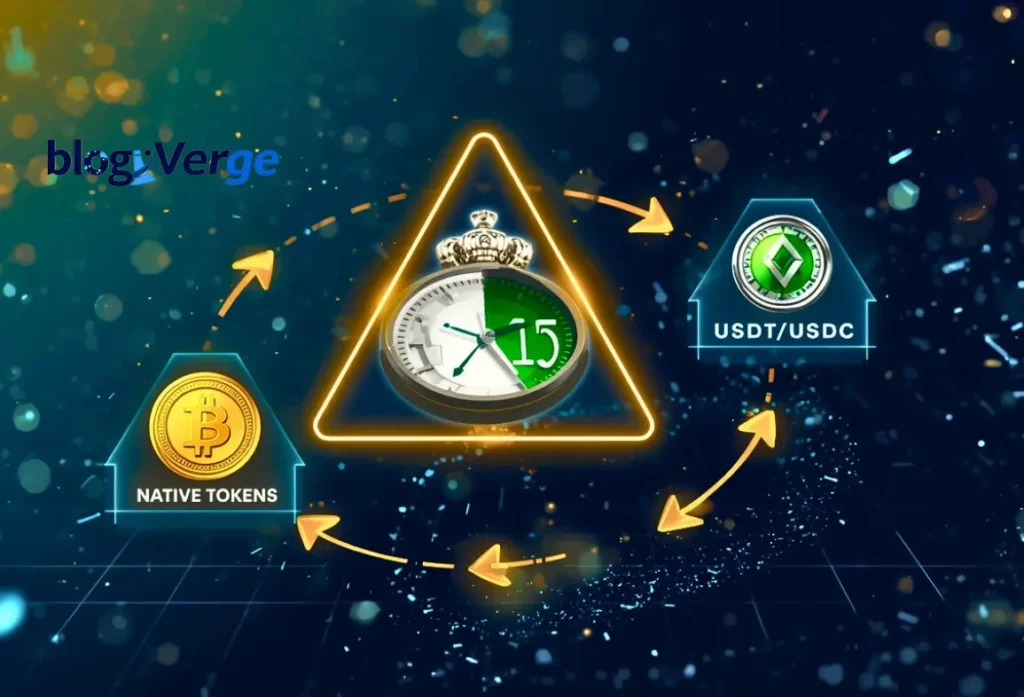The investment in cryptocurrencies has long since left the speculative game. Currently, the number of investors considering cryptocurrency with dividends as a passive income source is on the rise. At the same time, they can enjoy the prospective growth of the digital assets. While conventional cryptocurrencies focus on capital gains, dividend cryptocurrencies provide holders with regular payouts. Such rewards can be in the form of transaction fees in the network or staking, or even the business profits shared by the platform.
The idea is akin to the holding of dividend-packed stocks in the conventional financial world. By offering both growth prospects and regular earnings, dividend cryptocurrencies serve as a worthwhile addition to long-term investors’ portfolios. In this guide, we define all aspects of dividend cryptocurrencies, such as types, advantages, risks, setup strategies, and practical examples.
Table of Contents
Understanding Dividend Cryptocurrencies
What Are Cryptocurrencies with Dividends?
Cryptocurrency with dividends is any token that allocates some of the income or profits of the network to holders. This aspect generates a flow of passive income to the investors. Although Bitcoin and Ethereum are mainly dependent on the rise of values, dividend-paying tokens enable owners to reap a regular income without necessarily needing to sell their possessions.
Key sources of dividend income include:
- Transaction Fees: Depending on their networks, some blockchain networks distribute transaction fees to holders as a reward due to their contribution to the ecosystem.
- Staking Rewards: Proof-of-Stake (PoS) tokens reward individuals who lock their assets to verify transactional checks.
- Business Profits: Platforms generating utility/governance tokens can distribute a portion of their profits to token holders.
Types of Cryptocurrency with dividends
Proof-of-Stake (PoS) Tokens
Pos tokens induce users who are involved in network validation. Users are encouraged to stake their tokens, which helps increase the network’s security, and they are rewarded according to their holdings. Examples include:
- Cardano (ADA): It is characterized by a high amount of community and recurring staking rewards.
- XTZ: Rewards bakery and proactive governance.
- Algorand (ALGO): Rewards will be autocompounded and distributed daily.
Masternode Tokens
Masternode tokens require users to secure a certain quantity of cryptocurrency as collateral to operate a node, thereby securing the network. Transaction fees, in turn, give the operators dividends. Examples:
- Dash (DASH): Dash is an example of a node pioneer, and it shares network fees with the node operators.
- PIVX: Masternode providers will benefit through secure and private transactions.
Utility and Governance Tokens
Some platforms allocate the profits from business activities, lending services, or exchange operations to the token holders. Examples:
- Nexo (NEXO): Shares the profits of lending services with the holders of tokens.
- KuCoin Shares (KCS): Repays profits of exchange fees to the KCS holders.
How Dividends Are Paid

The Cryptocurrency with dividends may be distributed in various forms, and they all have their own merits:
Native Tokens
Numerous platforms remunerate users using the native Cryptocurrency with dividends in the project. For instance, holding Tezos tokens yields XTZ rewards. Although this approach increases token holdings, it puts users at risk of price fluctuations.
Stablecoins
Other networks pay a dividend in stablecoins such as USDT or USDC. This offers a steady revenue stream without risking fluctuations in the prices of the tokens.
Frequency of Payouts
The payout may be done daily, weekly, monthly, or quarterly. Frequent allocations will enable investors to reinvest yields and enjoy the compounding effect, which will continue to grow their portfolio over time.
Advantages of Cryptocurrency with dividends
- Passive Income: Passive income refers to the earnings of money without the need for active trading or market observation.
- Compounding Returns: Reinvestments that are made in the form of dividends can significantly contribute to long-term growth.
- Portfolio Diversification: Lentils’ adherence to price appreciation.
- Green Etchings: PoS tokens consume substantially less energy compared to Proof-of-Work networks.
- By engaging in governance decisions, most project holders derive more value than they would from dividends.
Risks of Cryptocurrency with dividends
Dividends are a fixed flow of revenues, and investors must know about the risks of dividend-associated issues:
Market Volatility
Cryptocurrency with dividends is volatile in terms of price. Even regular dividends may be offset by a drastic loss of token value to neutralise income benefits.
Platform Risk
Platforms may fall, be attacked, or be run poorly. This can lead to loss of primary and expected dividend levels.
Regulatory Uncertainty
Cryptocurrencies are varied in the world. The government can impose taxes, restrictions, or reporting requirements on dividend payments.
Smart Contract Vulnerabilities
Many dividend engines are done on smart contracts. The code might include bugs or exploits which can defeat payouts, so it is essential to use audited platforms.
How to Choose the Right Cryptocurrency with dividends

1. Evaluate Track Record
Fraud Track record of regular dividend payments. Longevity and reliability portray stability.
2. Check Staking or Masternode Requirements
Know the minimum holding and technical requirements to qualify for dividends.
3. Analyse Use Case and Adoption
The higher the rate of token adoption, the longer the reward would last. Problems/products that are solved through search engines and are highly used.
4. Review Security and Audits
Ensure that outside specialists review the project with the assistance of security audits. The use of open source codes and transparent groups minimises the exploits.
5. Consider Reward Rate and Volatility
High compensation is inherently risky. Strike a balance between potential revenue and market stability to avoid unwanted losses.
Setting Up to Earn Dividends
Step 1: Create a Compatible Wallet
Take a wallet that can hold the dividends. A hardware wallet is the best way to ensure long-term security.
Step 2: Purchase Tokens
The tokens needed can be acquired at trusted exchanges or the official project site.
Step 3: Stake or Lock Tokens
Introduction: Launder, stake or lock tokens. It consists of automated staking on selected platforms.
Step 4: Monitor and Reinvest
Periodically, note your dividends. By rewarding, gains may be increased and the portfolio growth rate enhanced.
Tax Considerations
You can also tax the Cryptocurrency with dividends income depending on your jurisdiction. To stay compliant:
- Maintain good records of different payouts.
- Understand reporting of income.
- In a complex or international circumstance, a tax expert must seek the counsel of a tax expert.
Best Practices for Dividend Crypto Investors
- Invest in different projects to reduce risk. Investments in over one token.
- Hear all: Music station news, network updates and community news.
- Safe Wallet: Lock out unauthorised access to hardware wallets and allow multi-factor authentication.
- Tactical governments: Do not possess, but love to lose.
- Keep an eye on your ROI and dividend performance through reliable analytics tools.
Popular Cryptocurrency with dividends in 2025
- Cardano (ADA) is a reliable PoS network wherein the rewards in question are consistent.
- Tezos (XTZ): Community governance practice or on use with the use of the bakery.
- Algorand (ALGO): A PoS network that has dividends at low prices per day.
- Dash (DASH): Fraction of transaction Masternode.
- Nexo (NEXO): a utility token, which is a profit-sharing plan on a lending platform.
Strategies for Maximising Returns
- Manage risk effectively by diversifying into several dividend-paying tokens.
- Reinvest the dividends to enjoy the mutual benefits of compounding.
- Oversee the network carefully to ensure fees are controlled and payout plans optimised.
- Steer clear of tokens with extreme risk, unusually high yields, or an unstable recent history.
Conclusion
Combining passive income with price appreciation offers a strong balance—providing both a stable income stream and potential price growth, primarily when investing in dividend-paying cryptocurrencies. Even though there are some risks, dividend crypto can be added sustainably to any portfolio with the help of the appropriate research, diversification, and security. Understanding payout systems, recognising reliable projects, and focusing on sustainable returns empower investors to generate long-term revenue in the ever-evolving digital asset landscape.
FAQs
Q1. Dividend-paying cryptocurrency? What is that?
Ans: Such a cryptocurrency rewards investors by sharing part of its profits or staking returns with them.
Q2. Cryptocurrency with dividends frequency?
Ans: It is project-based and could be daily, weekly, monthly or quarterly.
Q3. Do digital dividends attract tax?
Ans: Yes. In the majority of countries, the dividend income is subject to taxation. Consult local regulations.
Q4. Can I incur a loss of my principal in the form of drawing dividends?
Ans: Yes. The risks that could negatively impact your investment are listed above: market volatility and platform risks.
Q5. What do the maximum dividends of cryptocurrencies say?
Ans: These are the most popular ADA, XTZ, ALGO, DASH, and NEXO—research on their current returns and the quality of the platform.
Q6. How do you start to receive the dividends?
Ans: Create a compatible wallet, purchase tokens, stake or lock them, and regularly track your payouts.
Q7. Are less risky stablecoin dividends?
Ans: Stablecoin dividends have the potential to lower price sensitivity; however, they can be less rewarding than native token rewards.
Q8. Create the distinction between the masternode rewards and the PoS rewards?
Ans: Network validation is the way to earn the PoS rewards, and operating a full node by sharing transaction fees is a way to earn the masternode rewards.
Q9. Can I compound my dividends?
Ans:Yes. Reinvested dividends will translate to increased holdings, potentially leading to compounded returns in the long run.
Q10. How do I mitigate the risk in dividend crypto?
Ans: Divest, banksafe wallets, network patrol.

